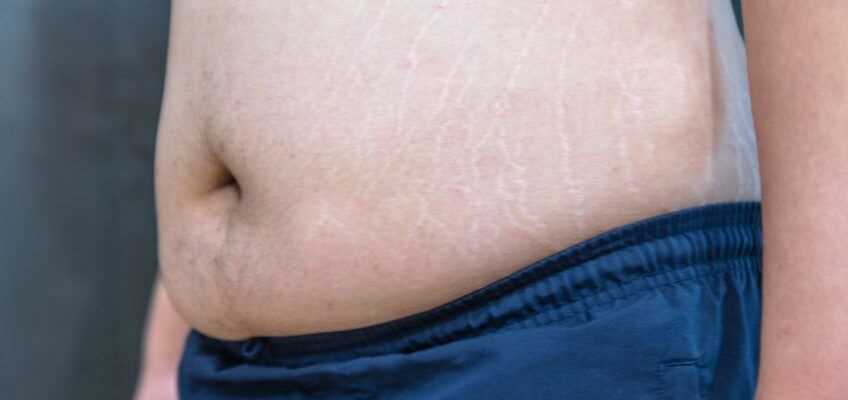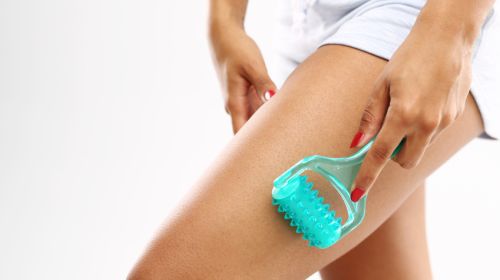If the connective tissue is weak, there is a risk of sagging skin, "winking arm" and cellulite. Usually the cause lies in the natural aging of the skin and reduced collagen formation. In this way you can prevent annoying stretch marks and strengthen weak connective tissue.
In order to understand what is behind a weak connective tissue, one has to know what the connective tissue does and what it is made of. Connective tissue is found in all organs of the body and pervades muscles, fascia, organ sheaths such as pericardium or spleen capsule, right down to the outer layers of the skin. They form the flexible supporting skeleton of the actually soft organs and give them stable structures. The most important building material for the connective tissue are collagen fibers. They keep all connective tissue tight and elastic.
Connective tissue weakness: The supporting tissue slowly weakens
In the course of time, the production of colleagues in the body decreases and the building material for the fiber skeleton of our muscles, tendons and ligaments is only installed in the areas that are important for the body. These are mainly elastic organs such as the heart and blood vessels. On the other hand, savings are first made in the skin and muscles. So the connective tissue weakness is much more a lack of collagen fibers, which develops over time and is completely natural. Hereditary collagen deficiency diseases such as Marfan's syndrome, which can already be identified in childhood, are significantly less common.
Orange peel, spider veins and varicose veins as a result of weakening connective tissue are the visible expression of a decreasing collagen content and are accordingly treated in medicine not as a disease but more as a visual change in the body from an aesthetic point of view.
Cellulite: What Really Helps?
Lifeline / week
Causes of a weak connective tissue
While the result of connective tissue weakness is visible and easy to diagnose, medical professionals do not fully agree on the causes. A multitude of factors that add up to cellulite or sagging facial areas appear to be causative. Possible triggers are obesity or an unbalanced diet and can cause orange peel to develop at a young age.
The number of collagen fibers in the connective tissue is responsible for the elasticity of the skin and the strength and stability of the supporting apparatus of the internal organs. This factor can be genetically influenced and a weak connective tissue can be inherited. In principle, this affects both sexes equally, but the different distribution of fatty tissue under the skin in men and women indicates a reduced amount of collagen fibers in women earlier.
Stretch marks from rapid overstretching of the skin
In order for a reduced amount of collagen in the body to turn into the classic symptoms of connective tissue weakness, i.e. cellulite, spider veins or stretch marks, the tissue of the skin must be mechanically overstretched faster than the skin can naturally compensate for it. Excessive weight gain, an increase in muscle mass due to extreme physical training and, in women, a rapidly growing baby bump often leave the skin with insufficient time to stretch.
The fibrous connections of the subcutaneous tissue become loose or tear and stretch marks or stretch marks form on the stomach, chest, arms or thighs. Even a pendulum of the weight with frequent gain and loss tires the connective tissue and even young, firm skin loses tension. These areas then also appear on curves that are otherwise likely to be bulging, such as the buttocks or the thighs, with a flattened and dimpled surface and the image of orange peel is evident even in slim people.
In old age: the body saves lysine and vitamin C for the heart or blood vessels
Over the course of life, the body loses a considerable proportion of its original total amount of collagen in the body because it can no longer produce it sufficiently itself. The elementary building materials in collagen synthesis – lysine and vitamin C – have to be supplied through food, but are usually not available in sufficient quantities in the foods that are frequently consumed in order to serve all metabolic processes in the body.
The body saves vitamin C for the immune system and can no longer make it available for the production of new collagens. The little collagen that is still produced is built up in vital organs such as the heart or elastic blood vessels and is no longer available for the skin. This process becomes visible as natural aging of the skin.
However, if you are gentle on your skin and do not expect it to stretch, i.e. move little, you are not protected from weak connective tissue. If the body is not constantly signaling the need for new collagen in the skin and muscles, i.e. through a lot of exercise in everyday life, alternating showers and skin-tightening massages, the collagen will break down anyway, will no longer be replenished and also lead to premature skin aging.
Cellulite & stretch marks: the result of weak connective tissue
Stretch marks and orange peel are the end result of connective tissue weakness. There are many minor symptoms along the way, but most of them are not recognized.
Although weak connective tissue affects the whole body and can also affect the internal organs, the superficial signs on the skin are more noticeable. In the initial stage, this can be shown by an increased tendency to bruise, as the tissue – and thus also small blood vessels – tear more quickly and bleed in and form a bruise. After that, however, they heal again and initially regenerate. However, over time and with increasing weakness of the connective tissue, these micro-injuries no longer heal and the entire body changes:
The first varicose veins appear, spider veins appear, the skin becomes slacker, the cheeks begin to sag, bags under the eyes appear and the muscles and fat pads hang down loosely, on the stomach as a fat apron on the extremities as a waving arm or saddlebags. With the increased tension on the skin due to the weight of the muscles and fat pads, the skin is stretched and what the doctor calls striae.
Connective tissue weakness also affects internal organs
Since the body reserves the collagens produced for its vital systems, weak connective tissue is only noticeable in the internal organs in a weakened form. However, the flexibility of vessels decreases sharply when there is weak connective tissue and the veins become calcified. Individual organs such as the lungs, heart or eyes can be more affected than the rest of the body. Here organ-specific symptoms of the disease appear, which are often not immediately associated with a weak connective tissue and can only be explained by the overall picture of the patient.
Marfan's syndrome is a genetic disease that causes the weakness of the connective tissue. In this rare hereditary disease, the organs do not develop physiologically, which means that they do without the elastic building materials in their growth and often grow together with scars and cannot function properly.
Treat connective tissue weakness: Strengthen weak tissue
If cellulite, varicose veins and stretch marks are already known within the family, then you should start tackling weak connective tissue at a young age. Even if the treatment methods for connective tissue weakness are limited, there are individual measures that prevent the formation of orange peel and spider veins and also give already weakened connective tissue more tension.
Tighten connective tissue inside and out
Before the cosmetic surgeon can remove the visible signs of connective tissue weakness such as cellulite or varicose veins as a last resort, there are three treatment approaches that you can use to keep your connective tissue tight yourself or to strengthen an already weakened connective tissue:
Strengthening connective tissue with exercise: Anyone who is constantly on the move, strengthens the muscles through training and further promotes muscle building, also constantly sends signals to the body that new collagen is needed in muscles, tendons and ligaments. This spurs the body on to keep producing collagen. In addition, sport combats the actual cause of the connective tissue weakness, namely that the body no longer provides enough building material for the flexible fibers and the elastic supporting skeleton becomes weaker.
A variety of Cellulite care products contains active ingredients that can easily be applied to the skin and provide collagen directly or whose components are intended to support and stimulate the production of collagen in the body. While that Coenzyme Q10 The aim of accelerating the synthesis of collagen is used in other products finished collagen offered for installation directly in the skin. The real difficulty here lies in the skin barrier, which does not allow the active ingredient to pass through the cell layers above a certain molecular size, so that the collagen cannot penetrate to its place of installation and is only deposited on the surface.
caffeine shows a verifiable effect on the contouring of the thighs, bottom or eye area. It easily penetrates the layers of the skin and the skin tightens. However, the effect only lasts for hours.
Almost all care products against orange peel take care of the skin a lot of moisture. If the skin cells are full of water, small dents disappear, at least visually.
Since inflammatory processes also damage the complexion, they also contain care products for connective tissue buckeye or red vine leaves anti-inflammatory Active ingredients. These are particularly suitable for the treatment of weakened leg veins in order to prevent varicose veins.
The manufacturers of anti-cellulite creams often recommend the Massage the active ingredient into the skin. Individual manufacturers offer their products directly with applicators that act as massage balls and distribute the active ingredient on the skin. The mechanical irritation of the Stimulates skin the new production of collagens, the ointment and the moisture it contains works mechanically through the skin barrier and promotes blood circulation, making the tissue feel plumper and smoothing out small bumps in orange peel.
One Increased blood flow can with Alternating showers, i.e. multiple rinsing of the legs with warm and then cold water.
Strengthen the fibers of the connective tissue from the inside
So that new collagen can be formed, the necessary building materials must be taken from food. Are particularly important here Food with lysine and vitamin C., as these two components already play a decisive role at the beginning of collagen synthesis. They are also needed for other important processes in the body, such as the immune system. In the event of an undersupply, the nutrients are then not available for the new production of collagens.
Collagen is also available in drinking ampoules. Unlike collagens in foods such as meat, the colleagues contained therein are not largely digested and therefore unusable, but rather should be absorbed by the body.
Certain trace elements are said to have a beneficial effect on the connective tissue. These are partly ingested through food, for example Zinc, iron or calcium, or supplemented by homeopathic complex remedies. The Silica becomes Also attributed to connective tissue strengthening properties.


